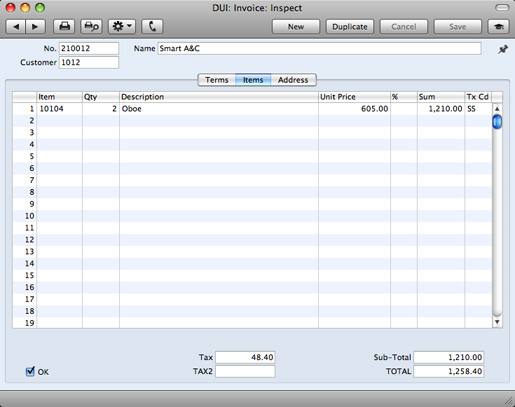Entering an Invoice - Items Card
Use the grid on the 'Items' card to list the invoiced Items. To add rows to an Invoice, click in any field in the first blank row and enter appropriate text. To remove a row, click on the row number on the left of the row and press the Backspace key. To insert a row, click on the row number where the insertion is to be made and press Return.
You can also bring Items into an Invoice by opening the 'Items: Browse' or 'Paste Special' windows, selecting a range of Items by clicking while holding down the Shift key, and then dragging them to the Item field in the first empty Invoice row. You can also copy a list of Item Numbers from a spreadsheet or word processor and paste them in the Item field in the first empty row.

- Item
- Paste Special
Item register
- With the insertion point in this field, enter the Item Number for each Item sold. Pricing, descriptive and other information will be brought in from the Item record. If you leave this field blank, you can enter any text in the Description field, perhaps using the row for additional comments to be printed on Invoice documentation.
- Qty.
- Enter the number of units sold. If you leave the field by pressing the Return or Enter key, the insertion point will move to the Item field in the next row.
- Description
- Default taken from
Item
- This field shows the name of the Item, brought in from the Item register. If you want to add an extra description, you can do so: there is room for up to 100 characters of text. You can also use the next line if necessary.
- In multi-user systems, you can prevent certain users from changing any Description in an Invoice using Access Groups (by denying access to the 'Change Item Description on Invoice' Action).
- Unit Price
- The Unit Price according to the Customer's Price List is brought in. If the Customer does not have a Price List, or the Item is not on the Price List in question, the Price from the Item record is brought in. This figure will include Sales Tax if the Price List is one that is Inclusive of Tax or if you have specified in the Account Usage A/R setting that Prices include Tax.
- In multi-user systems, you can prevent certain users from changing any Unit Price in an Invoice using Access Groups (by denying access to the 'Change Unit Prices' Action).
- %
- Discount percentage.
- In multi-user systems, denying access to the 'Change Unit Prices' Action described immediately above will also prevent the entering of a discount percentage.
- Sum
- The total for the row: Quantity multiplied by Unit Price less Discount. Changing this figure will cause the Discount Percentage to be recalculated. This figure will include Sales Tax if the Price List specified is one that is Inclusive of Tax or if you have specified in the Account Usage A/R setting that Prices include Tax.
- In multi-user systems, denying access to the 'Change Unit Prices' Action described immediately above will also prevent the changing of a row sum.
- Tx Cd
- Paste Special
Tax Codes setting, General Ledger
- The Tax Code entered here determines the rate at which Tax will be charged on the Item and the Output Tax Account to be credited.
- The default offered in each row will be chosen as follows:
- The Sales Tax Code for the Customer will be used.
- It will be taken from the Item record.
- The Tax Code in the Account Usage A/R setting will be used.
In the cases of points 2 and 3, the correct Tax Code for the Zone of the Customer will be used.
- You can change this default in a particular Invoice row if necessary.
>
Footer

The Invoice Footer contains various running totals as described below. Whenever you add or change an Invoice row, these totals will be updated automatically.
- OK
- You can approve the Invoice by checking this box and saving. This will cause the Invoice to be posted to your Accounts Receivable. A corresponding General Ledger Transaction will also be created in the Transaction register. Because of this consequence, you will no longer be able to make changes to the Invoice.
- In multi-user systems, you can use Access Groups to control who can approve Invoices and Credit Notes. To do this, deny access to the 'OKing Invoices' and 'OKing Credit Notes' Actions respectively.
- If you would like a warning to appear every time you save an Invoice that you have not approved, please refer to the Global Warnings on UnOKed Records setting in the System module.
- References in these web pages to approved Invoices are to Invoices whose OK box has been checked (i.e. an approved Invoice is one that is no longer a Draft).
- Tax
- The Sales Tax total for the Invoice.
- This figure is rounded up or down according to the Default for Currency rounding rules set in the Round Off setting in the System module.
- Sub-Total
- The total for the Invoice, excluding Sales Tax.
- This figure is rounded up or down according to the Default for Currency rounding rules set in the Round Off setting in the System module.
- TOTAL
- The total for the Invoice, including Sales Tax.
This figure is rounded up or down according to the Total rounding rules set in the Round Off setting in the System module. In the General Ledger Transaction resulting from an Invoice, any amounts lost or gained in this rounding process are posted to the Round Off Account specified in the Account Usage A/R setting.
---
In this chapter:
Go back to:
